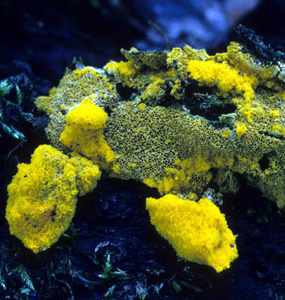Trichia favoginea

Image Courtesy of Emily Johnson
| Click to Enlarge |
| Click For Image Gallery |
|
Group of Fungi: Slime Molds Family: Trichiaceae Latin Name: Trichia favoginea (Batsch) Pers. Common Name: None Description: Globose to ovate or somewhat cylindrical, structures, up to 1/16 in (0.15 cm) tall and 1/64–1/32 in (0.05–0.1 cm) in diameter, crowded together in groups that may be 1–2 inches (2.5–5 cm) in total extent; surface bright yellow or yellow brown and more or less shining; spores yellow to ochraceous in mass. Biological Role: Like all other slime molds, the vegetative stage (called a plasmodium) in the life cycle of this organism feeds upon the bacteria associated with decaying plant material. Habitat: On decaying wood or bark in broadleaf or conifer forests; individual fruiting bodies crowded together in small or large groups. Geographical Distribution: Found throughout the world. Comments: The slime molds are not true fungi but are found in many of the same situations. Because of the yellow color of the fruiting bodies, Trichia favoginea is relatively easy to spot against the darker wood or bark upon which it occurs. This is certainly the case for large fruitings. |
| Go Back |